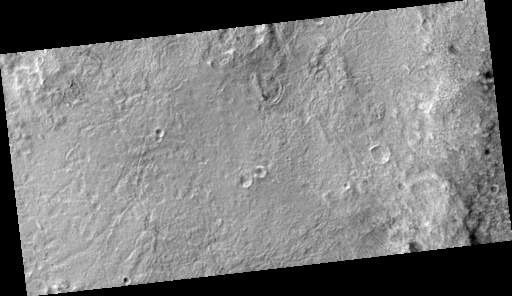The Floor of Niger Vallis: Bearer of Ancient Floodwaters?
 This color image covers only the center swath of
the full image, and is composed of images acquired through infrared, red,
and blue-green filters. The color has been enhanced to better show the
subtle color differences. It is not natural color or how it would appear
to normal human vision.
This color image covers only the center swath of
the full image, and is composed of images acquired through infrared, red,
and blue-green filters. The color has been enhanced to better show the
subtle color differences. It is not natural color or how it would appear
to normal human vision.
This image shows a portion of the floor of Niger Vallis, an ancient Martian outflow channel. Niger Vallis originates on the flanks of the volcano Hadriaca Patera, and empties into the Hellas impact basin. Outflow channels are observed in many regions of the planet, and may have been carved by brief eruptions of liquid water from beneath the surface. Since Niger Vallis formed, impacts have cratered the channel floor, and fine-grained wind-blown debris has been transported across the surface, eroding and burying all but the freshest craters. The curved ridge in the scene may be the remnant of a large crater rim. At the high resolution of this image, a pattern of parallel dunes and ripples can be seen, as well as individual boulders as large as two meters across.
Image TRA_000830_1440 was taken by the High Resolution Imaging Science Experiment (HiRISE) camera onboard the Mars Reconnaissance Orbiter spacecraft on Sunday, 01 October 2006. The complete image is centered at -35.4 degrees latitude, 92.1 degrees East longitude. The range to the target site was 255.5 km (159.7 miles). At this distance the image scale is 51.1 cm/pixel (with 2 x 2 binning) so objects ~153 cm across are resolved. The image shown here [below] has been map-projected to 50 cm/pixel and north is up. The image was taken at a local Mars time of 3:35 PM and the scene is illuminated from the west with a solar incidence angle of 77 degrees, thus the sun was about 13 degrees above the horizon. At a solar longitude of 113.8 degrees, the season on Mars is Northern Summer.
 HiRISE Product ID: TRA_000830_1440_RED
HiRISE Product ID: TRA_000830_1440_RED
Images from the High Resolution Imaging Science Experiment and additional information about the Mars Reconnaissance Orbiter are available online at:
http://www.nasa.gov/mro
or
http://HiRISE.lpl.arizona.edu.
For information about NASA and agency programs on the Web, visit: http://www.nasa.gov. NASA's Jet Propulsion Laboratory, a division of the California Institute of Technology in Pasadena, manages the Mars Reconnaissance Orbiter for NASA's Science Mission Directorate, Washington. Lockheed Martin Space Systems is the prime contractor for the project and built the spacecraft. The HiRISE camera was built by Ball Aerospace and Technology Corporation and is operated by the University of Arizona.
